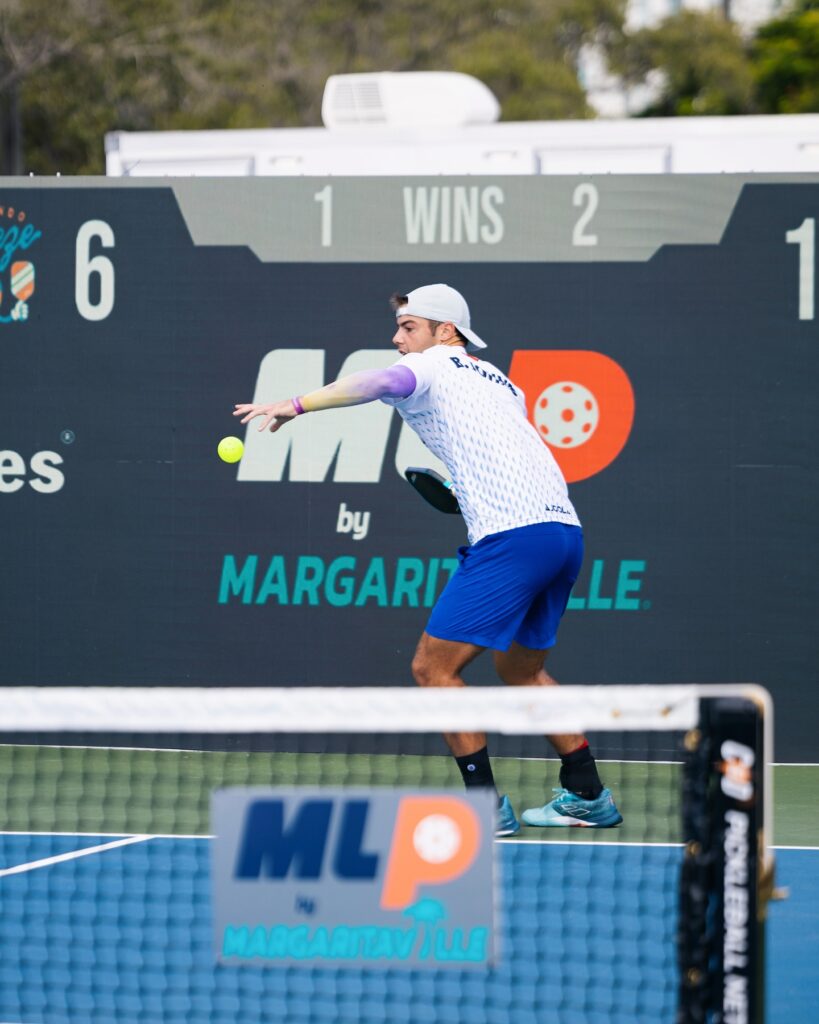Nothing sparks a heated debate at the pickleball courts quite like rally scoring in pickleball.
Some players swear by it, claiming faster games and predictable match times.
Others? They’ll tell you it’s ruining the strategic essence of traditional pickleball.
I’ve seen friendships tested over this scoring system (okay, maybe that’s a bit dramatic, but you get the point).
Whether you’re scrolling through pickleball forums or chatting between games, rally scoring has become one of those topics that gets everyone fired up.
So, what is rally scoring in pickleball?
There are real pros and cons that every player should understand before taking a side in this great pickleball debate.
Let’s get started.
What is Rally Scoring?
Let’s get straight to the basics – and trust me, this is where the controversy begins.
Rally scoring means a point is scored on every single rally, regardless of which team is serving.
Sounds simple, right?
Well, that’s where the agreement ends.
How It’s Different From Traditional Scoring
In traditional pickleball scoring (or side-out scoring), you can only win a point when your team is serving. Miss a shot while returning? No problem – you just lose the serve, not a point. It’s forgiving that way, and many players love this aspect of the game.
But rally scoring? It changes everything.
That casual dink that goes into the net? Point for your opponents.
That serve you usually “just get in”? Better make it count.
That aggressive shot you love to take? Think twice.
The Numbers Game
Traditional games go to 11 points, but rally scoring typically uses 15 points (win by 2). Some formats even go to 21, but let’s not open that can of worms just yet.
Here’s where it gets interesting: Traditional scoring purists argue that 15 points isn’t enough to develop the strategic ebb and flow that makes pickleball special. Rally scoring advocates counter that it creates more intense, focused play from the very first serve.
The Serving Situation

The biggest mind-shift comes with serving.
In traditional scoring, losing your serve just means switching sides.
In rally scoring, every service fault is literally giving away a point.
For some players, this added pressure enhances the game. For others, it’s exactly what they’re trying to avoid during their recreational play.
Benefits of Rally Scoring: Why Some Players Are Making the Switch
Faster, More Predictable Games
The biggest win for rally scoring? Time management. Pure and simple.
Those marathon games that used to ping-pong back and forth for 45 minutes? They’re history.
Rally scoring typically wraps up in 15-20 minutes, and that predictability is huge for tournament directors and busy players alike.
“I can actually plan my day now,” a tournament director recently told me. “No more matches backing up the entire schedule.”
Increased Intensity

Here’s where rally scoring really shines for its fans: Every. Rally. Matters.
The intensity level shoots up because each point is on the line. Supporters argue this creates:
- More focused play from the start
- Higher quality shots and decision-making
- A better workout in a shorter time frame
Tournament-Friendly Format
Tournament organizers are some of the biggest rally scoring advocates, and for good reason:
- More matches can be scheduled with confidence
- Players get consistent rest periods between games
- Events finish on time (mostly!)
Learning Curve Benefits
Surprisingly, many new players find rally scoring easier to grasp. There’s no confusion about side-outs or which score belongs to whom. You play, someone gets a point. Simple.
The Mental Game Advantage

Some players swear rally scoring has improved their mental game. When every point counts, you learn to:
- Stay focused throughout the entire game
- Recover quickly from mistakes
- Make smarter shot selections
The Case Against Rally Scoring: Why Traditionalists Are Pushing Back
“It’s Not Real Pickleball”
Let’s address the elephant on the court – many longtime players believe rally scoring fundamentally changes the sport they fell in love with.
“You lose the natural flow of the game,” as my friend Tom, a 5-year pickleball veteran, puts it. “Traditional scoring allows for comebacks, adjustments, and real strategic development.”
The Pressure Problem
Not everyone wants their casual games to feel like tournament play. Common complaints include:
- Too much pressure on every single shot
- Less enjoyment during recreational play
- Newer players feeling discouraged faster
- Social aspects of the game getting lost
Strategy Gets Sacrificed

Here’s where traditionalists make their strongest case: Rally scoring can actually reduce strategic play. How?
The shorter games mean less time to:
- Figure out opponent weaknesses
- Develop complex strategies
- Make meaningful adjustments
- Build momentum
The Serving Dilemma
In traditional scoring, players can use their serve as a way to get into the rhythm of the game. With rally scoring?
“Miss your serve, pay the price,” as they say. This creates:
- More conservative serving
- Less experimentation
- Added pressure on an already technical aspect
Social Impact

Perhaps the most overlooked drawback – rally scoring can change the social dynamic at recreational courts:
- Games end faster, disrupting established playing groups
- Less chat time between points
- More intense atmosphere, even in casual play
Getting Started: Making Both Scoring Systems Work for You
Reading the Room
First things first – know your audience. Different situations call for different scoring:
Tournament or League Play? Be ready for rally scoring. It’s gaining traction in organized play, and you’ll want to practice this format before competing.
Casual Drop-In Games? Read the vibe. Most recreational groups still use traditional scoring, but don’t be afraid to suggest rally scoring for a change of pace.
Tips for Traditional Scoring
If you’re sticking with traditional scoring:
- Use the side-out opportunities to catch your breath
- Take time to develop your strategy
- Don’t get discouraged by long games without points
- Enjoy the social aspects between serves
Tips for Rally Scoring
When playing rally scoring:
- Stay focused from the first serve
- Practice more conservative shot selection
- Keep your serve consistent (this is huge!)
- Be mentally prepared for faster-paced games
Making the Transition
Want to experiment with both? Here’s how:
- Start with traditional scoring during warm-up games
- Switch to rally scoring for your “serious” games
- Try both formats in practice games
- Get comfortable adapting to either style
The Bottom Line
Here’s the truth about scoring in pickleball: Both systems have their place in the sport. The key is being flexible and understanding when to use each one.
The Final Serve: Embracing Both Sides of the Scoring Debate
At the end of the day, pickleball isn’t really about the scoring system – it’s about the joy of the game, the friendships we build, and the fun we have on the court.
Rally scoring isn’t killing pickleball, and traditional scoring isn’t holding it back. They’re just different tools in our pickleball toolbox, each serving its own purpose.
Here’s what really matters:
- Play what works for your group
- Be open to trying both systems
- Focus on improving your game, regardless of scoring
- Remember why you fell in love with pickleball in the first place
The great scoring debate will likely continue at courts across the country.
And you know what? That’s okay. It shows how passionate we all are about this amazing sport.
Whether you’re Team Rally Scoring or Team Traditional (or somewhere in between), there’s room for everyone on the pickleball court. Just remember to call the score clearly – no matter which system you’re using!
Game on, pickleball family. See you on the courts!


